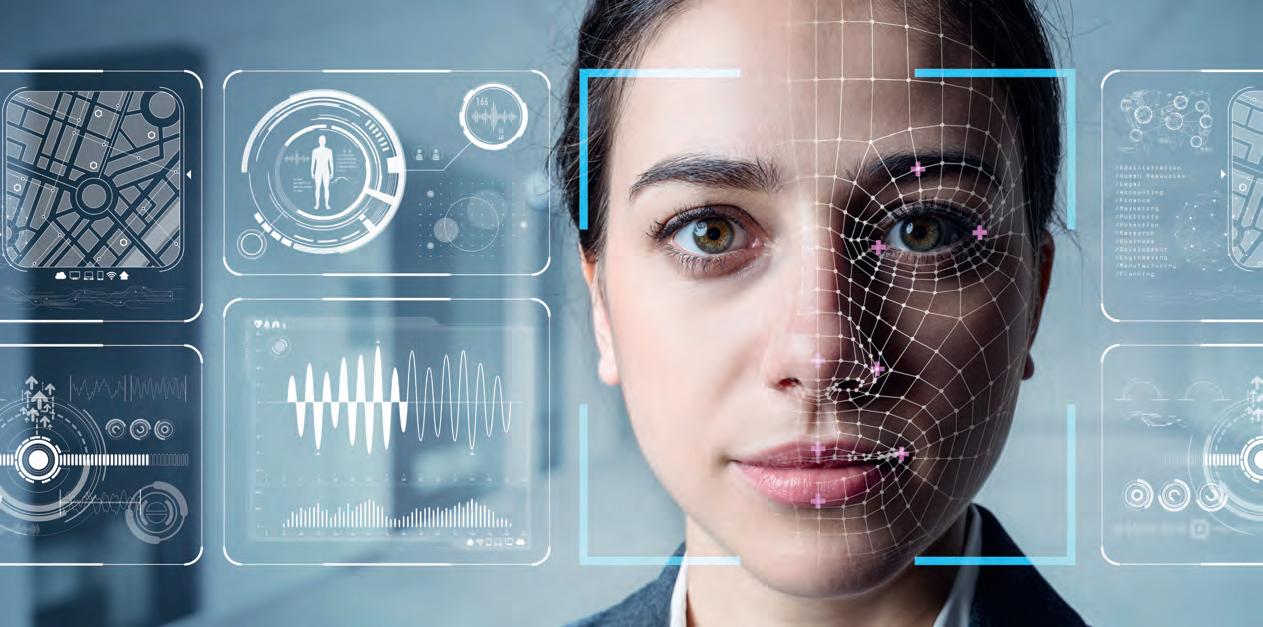
10 minute read
The new algorithm of lens development
The new algorithm of lens development
How “big data” and recent scientific findings led to the highest level of personalization available in a Zeiss lens
Designing a spectacle lens is a highly complex science, now more than ever, and it is based on thousands of measured values and research results: increasingly detailed refraction, centering values, changing visual behavior due to digital devices, frame shapes, age-specific facial anatomy, pupil sizes and eye age. With the latest version of the Zeiss SmartLife portfolio (available since 2023), the company has succeeded in developing an algorithm based on these data volumes that combines “big data“ with subjective and objective measurement results – and thus lays the foundation for even more individualized lenses. By Manuela Weinreich
Optical spectacle lenses have a history of more than 1,000 years of development. Since Abu Ali al-Hasan ibn al-Haitham, Alhazen in short, described the optical effect of curved lenses and ground magnifying glasses in the 11th century, we have seen countless innovations and milestones over the centuries that have made spectacle lenses better and better and correction options more and more individual. Today’s development and manufacturing of modern eyeglass lenses at Zeiss is based on four pillars:
Know-how about vision needs and visual behavior: consideration of visual behavior for the desired visual need and the intended use of the lens.
Knowledge about age-specific visual needs: consideration of visual needs in relation to anatomical and physiological changes, differences in lifestyle and habituation of the eyeglass wearer according to date of birth and age.
Optical know-how about the lens-eye-system: consideration of the interaction between lens and eye and its impact on the calculation and manufacture of lenses for the desired optical performance.
Know-how to optimize the aesthetics of the eyeglass lens: consideration of the interaction of the physical appearance of the lens and its optical performance.
The focus is not only on progressive lenses – which are known to place the highest demands on the production of spectacle lenses for many reasons. Lenses for young people are becoming more complex, they are changing and need to be adapted to our changing visual habits, as the latest developments show.
It is all about preventing high-grade myopia in young people, and new solutions for vision are currently groundbreaking. Finally, it is important to counter the “pandemic of progressive myopia,” especially in China. In brief: for the manufacturing of individual spectacle lenses, it is enormously important to understand our vision behavior and our lifestyle habits better and better in order to be able to offer products that enable better, clearer and also healthier vision — and are no longer based purely on statistics and standard parameters or on a “one size fits all” approach. As trivial as this may sound, it is in fact complex. After all, the basis of the latest vision research is “big data”. There has never been so much data about every single person in this world and the specific visual requirements of entire population groups and age groups as there is today. Zeiss makes use of this data, structuring and analyzing it in order to understand human vision better and better. As a result, the range of increasingly sophisticated, more individualized lenses is growing.
A case study of the individualization of a lens
Zeiss launched a completely new portfolio of premium lenses in 2018, named Zeiss SmartLife. The portfolio ranges from single vision to digital and progressive lenses. It is based on numerous technologies that are in place to ensure that those spectacle lenses (depending on the level) offer everything a modern lens must offer: refraction and centering values, consideration of the individual’s main activities, facial anatomy, frame shapes, consideration of individual habituation and the age-specific pupil dynamic and size.
In addition, the company has succeeded for the first time in incorporating data on actual viewing behavior across an entire portfolio into the lens design. The new portfolio is thus adapted to our mobile lifestyle, which is primarily characterized by the use of smartphones and tablets. But the special lens is even more: it is adaptive. This means that more and more knowledge about human vision is being incorporated into the lens design, resulting in increasingly individualized lenses for all age groups. The decisive factor here is that the complexity of the design is not at the expense of the partner eye care professionals. They get an improved and more individual product at hand but the consultation process, the fitting or even the ordering process does not change, everything remains as before.
Study situation
Let us take a closer look at the large data pool that provided important new knowledge for Zeiss SmartLife. Over a period of more than two years, the company has collected more than twelve million data records from eyeglass wearers, more than ever before.
The starting point was an online study that collected subjective data on the lifestyle of more than 300,000 consumers worldwide, and objectively measured data obtained with the help of a tracking procedure on viewing behavior. Both data pools were incorporated into the Zeiss Global Vision Study [1] of 2020/21.
In tracking visual behavior, millions of objectively measured data points were collected from the daily lives of several hundred individuals from the U.S., China, and Germany. The subjects were from various occupational groups with different social and cultural backgrounds and ranged in age from 21 to 80 years.
They were then divided into six age groups (21-30 years, 31-40 years, 41-50 years, 51-60 years, 61-70 years, 71-80 years). The study examined how these people see in everyday life, what visual demands they have at work, at home or in their leisure time and was thus able to provide researches with conclusions about their actual visual behavior.
Among other things, the study showed that the visual demands in the six age groups differ significantly from one another – in the sense of age-related differences in dynamics and in activity-dependent visual behavior.
It found that there is a difference between biological age and the socalled eye age, the optometric status of the eye (the actual visual acuity and habituation of the eyeglass wearer).
This information was added to the already known data from various studies on visual requirements, and based on this entire pool of data, an algorithm was developed to predict the visual behavior and thus the required lens design for the eyeglass wearer. This assumption has been transferred as the basis for the new design of Zeiss SmartLife.

More data, more possibilities
More individual data and parameters about the visual needs and behavior of eyeglass wearers allow for more possibilities and even more specific vision solutions for the individual. Nowadays it’s crucial to make use of these large and complex volumes of data by converting it into a large number of possible target designs.
While there were only a few hundred designs in the first generation of Zeiss SmartLife Individual, there are already more than forty thousand in Zeiss SmartLife Individual 3, which serve as the basis for the final lens. This is made possible by the use of the Zeiss Intelligence Augmented Design (IAD) algorithm. It uses all of the customer's data transmitted by the eye care professional, i.e. the specified lens type, individual prescription, frame data and age, and compares this data with the vision requirement profiles in the database in order to select the optimum design target. In a final step, all the customer's individual parameters are then used in an optimization process to adapt the lens to be manufactured as closely as possible to the optimal target design.
For illustration purposes: Let's take a 65-year-old eyeglasses wearer who is to be fitted with a Zeiss SmartLife Individual 3 progressive lens. To calculate the lens, the IAD algorithm requires the date of birth in addition to all order parameters.
This data is enriched with the large data pool, the biological age is compared with the eye age (based on the ordered addition) and the target design is calculated from this, resulting in the best possible individualized visual comfort for that 65-year-old.
This means that even if two customers of different ages have the same prescription, they will receive a lens design that is optimally matched to their visual needs, considering their individual visual habits and parameters.
In numbers that means: the optical performance of the new Zeiss SmartLife Individual 3 lenses is up to 29% better compared to previous SmartLife Individual lenses. In addition, 85% of wearers perceived wide fields of comfortable vision in all directions and at all distances [1]

Further study layers crucial for today's vision
New vision parameters have been incorporated into the large data pool for the new generation of all Zeiss SmartLife lenses. For example, the Zeiss Vision Science Lab at the University of Tübingen has researched the eye’s center of rotation.
Since the development of the eye model by Allvar Gullstrand (1911), one center of rotation has been assumed for all rotational movements of the eye based on prescription values. However, the study showed that the location of the rotation axis for vertical eye movements is significantly different from that for horizontal movements. The approach of the new SmartLife portfolio is primarily to take into account the changing visual behavior in today's smart and connected world and the increasingly dynamic vision with the many changes of gaze and “seeing out of the corner of the eye”, i.e. the increased need for peripheral vision.
Therefore, knowledge of the position of the horizontal and vertical eye rotation axis is particularly valuable in minimizing aberrations for the gazing eye when looking obliquely/peripherally through the lens. This is also shown by the investigations in our laboratories, in which we have determined corresponding limit values for determining the visual
range sizes and compared them with previous designs. This results in larger visual ranges for the new generation of Zeiss SmartLife lenses for the distance range than for the previous lenses and the digital and progressive lenses now also have larger visual ranges for looking at smartphones than for the previous SmartLife counterparts.
Conclusion: why spectacle lenses must always become more individualized
Over the past decade, refractive techniques, manufacturing processes, optical designs and consumer demands for lens performance have changed significantly. The flexibility, individuality and spontaneous tolerance of lenses is greater today than ever before.
Technology and personal needs, visual comfort and preferences, fashion trends, digitalization and big data continue to drive development. Although amazing strides have been made, for Zeiss this is only one step in the journey towards even more individualized lenses. ◆
References:
[1] Market consumer acceptance test on Zeiss SmartLife Individual 3 lens portfolio with n=172 study participants in DE, IT, CN by Carl Zeiss Vision International GmbH, DE 2022. (unpublished, data on file)

Picture: metamorworks/stock.adobe.com





